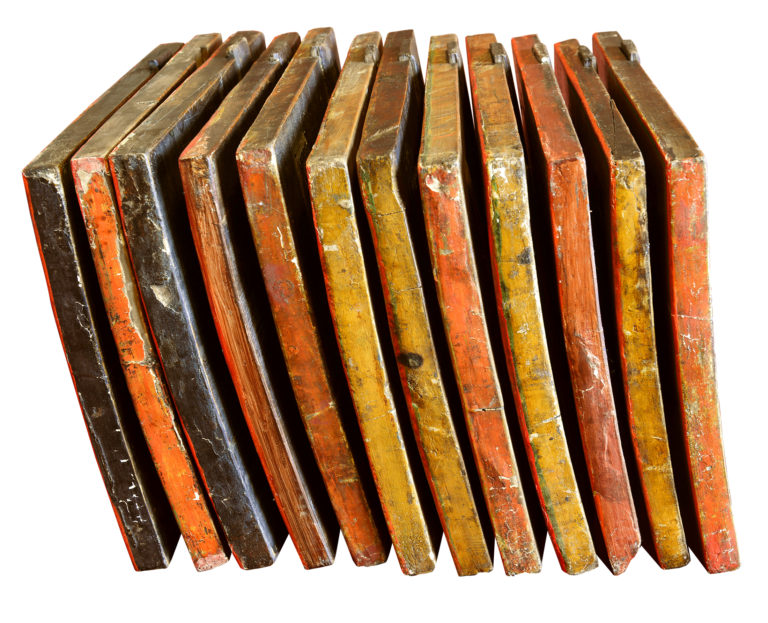The Yearly Menaion
The Yearly Menaion (a set of 12 icons of saints commemorated every month)
Second quarter – middle of the 19th century. Palekh.
| September Menaion | 31 х 26 х 2 cm |
view 3d
|
| October Menaion | 31 х 26 х 2 cm |
view 3d
|
| November Menaion | 31 х 25,5 х 2,3 cm |
view 3d
|
| December Menaion | 31,5 х 26,5 х 2,2 cm |
view 3d
|
| January Menaion | 32 х 26 х 2,3 cm |
view 3d
|
| February Menaion | 31,5 х 26 х 2,3 cm |
view 3d
|
| March Menaion | 31,5 х 26,5 х 2,2 cm |
view 3d
|
| April Menaion | 31,5 х 26,5 х 2,5 cm |
view 3d
|
| May Menaion | 31,5 х 26 х 2,3 cm |
view 3d
|
| June Menaion | 31,5 х 26,5 х 2,2 см |
view 3d
|
| July Menaion | 31 х 26,5 х 2,3 cm |
view 3d
|
| August Menaion | 31 х 26 х 2 cm |
view 3d
|
Contact us

The Yearly Menaion
All twelve icons of saints are painted with tempera on gesso and wood (predominantly on whole panels, with two thin support boards), absence of an incut centerpiece, possibly with an underlying layer of canvas.
The author’s paintwork is in fairly good state – with slight losses and restored pieces (especially evident on the sides). There are also thin scratches, toned replacements of the gesso, and barely visible fragments of darkened olifa evidently missed during restoration.
The yearly Menaion, also known as a Minyeia or Menology, is a complex of 12 hand-painted Orthodox icons representing the saints and major Church Feasts in order of their commemoration, from September to August. This particular set of antique Russian icons is unique since it is both, complete (which is a great rarity) and excellently preserved.
The Menaion Icons (literally – “monthly icons”) became widespread in Russia in the second half of the 16th century, following the composition of the Great Menaion text composed under the supervision of Metropolitan Macarius of Moscow. Traditionally, these hand-painted Orthodox icons are small and are usually used for veneration of the analoion, where they are placed in accordance with their respective month.
The main samples, used by artists painting the Menaion religious icons, were the illuminated Vitas with commentaries. From the 18th century onwards, etchings became the predominant sample for iconographers, following the 1722 edition of Menaion etchings devised by the artist Gregory Tepchegorskii.
The images of the saints and feasts are separated into five successive rows (each of equal size) by thin white lines. The saints are depicted full-height in relaxed, natural poses, usually facing each other (the frontal poses ate almost absent). The decorative flair of the imagery is enforced by the golden background and the white medallions with the lettered symbols of the days.
The iconography of the given Menaion complex is noteworthy for its expanded number of saints and the detailed composition of the Feast scenes. Some scenes, such as the Adoration of the Magi and the Nativity of St. John the Baptist, are found only in the 19th-century antique Russian icons. Among other unique for this century images are the St. George’s Day (April 23rd) depicted as the Miracle of St. George and the Dragon and the December Menaion that includes the Massacre of the Infants at Bethlehem. Judging by the selection of rather rare saints and the character of the compositions, the illustrated Menaion religious icons were to be used among the Old Believers.
The character of the artwork – the subtle color pallet enriched by the golden background of the centerpiece, the introduction of active yellow and green pigments, and the rather rigged gold assist on the vestments – indicates that these antique Russian icons were painted in the second quarter or middle of the 19th century, in the recognizable style of Palekh artists. This is evident in the “miniature” painting with highly-descriptive depictions, the brilliance in composition, the architectural richness with its color schemes and white ornamentation, lights on the mountainsides, and the overall nostalgic loyalty to the old iconographic tradition. All of these elements were beloved and perfected by Palekh masters. The excellent preservation and exquisite artwork make this amazing set of hand-painted icons of saints a unique piece of religious icon art worthy of the highest value for both, museums and private collectors.